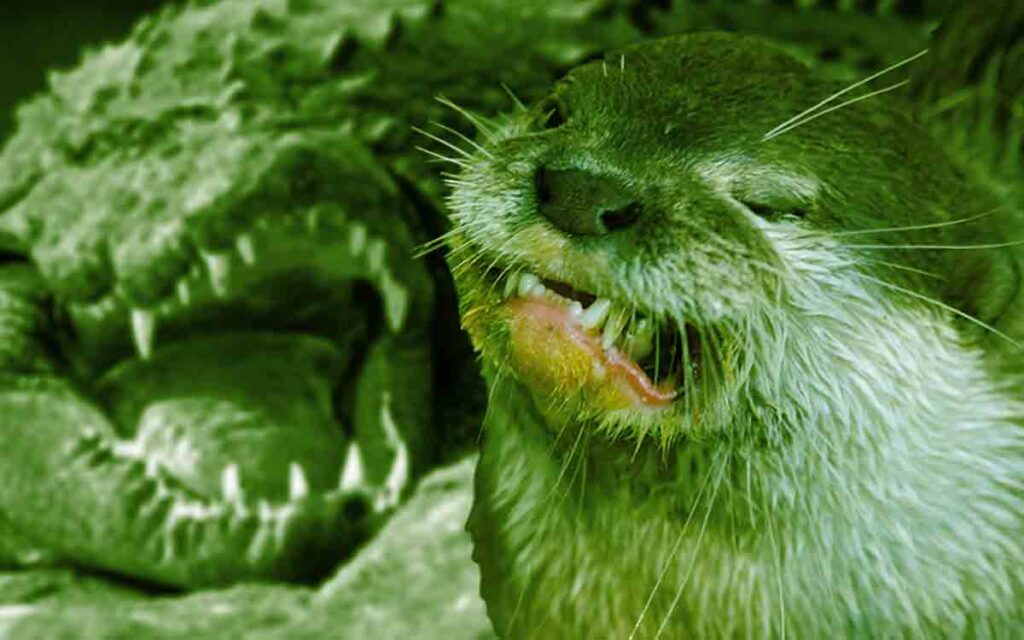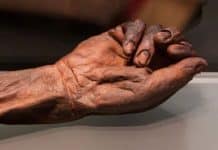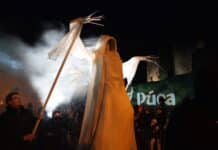The Dobhar Chu is a bloodthirsty monster that has been terrorising Ireland’s lochs for centuries, says guest writer, poet and Irish tour guide ROIBEARD MCELROY

The year was 1722 and it was a fair September day; the setting was county Leitrim in the north west of Ireland. The backdrop was the mystical mountain of Ben Bulben with its rich legend laden tapestry and the location was the mouth of the Glenade Valley.
It was at Glenade lake, that local woman, Grace Connolly, went to wash her clothes. The sands of time sprinkled themselves afar and Grace hadn’t returned home, two sources attest that either her husband Terence McLoughlin or her brother filled with foreboding at her not returning home went to the lake.
The sight that awaited them could have fitted right into a Hammer House of Horror film or a gory Hollywood biopic – poor Grace had been mauled to death and lying fast asleep across her prostrate and blood smeared and splattered body was an otter-like creature, its vampiric gargantuan fangs having been much satiated.
The indignant loved one when beholding the grim scene retreated to get his gun, came back slyly as the horrid ogre still slept, raised his gun and killed the creature. In its last moments before expiring, it emitted a death rattle, a terrifying shriek which must have acted like a signal of some sort, as from the deep abyss of Loch Glenade arose another creature – likely its partner.
The rider’s horse took fright and raced off and what ensued was a manic chase and pursuit of predator and its prey beginning at Frank McSharry’s of Glenade, over a distance of 20 miles around the side of Benbulben mountain close to the now main Bundoran-Manorhamilton road – taking in two counties Sligo along with Leitrim. It only ended when the rider took refuge at a blacksmith’s forge located at Cashelgarron Stone Fort, as the horse needed to be reshod.
It was there the wise blacksmith advised him of a plan to ensnare the fearsome creature. He would line two horses up at the entrance to the fort and wait behind the ditch at the side, lure the ogre in and then ambush it like a matador. The creature stooped downward and went right through the poor horse. The broken-hearted assailant drove downwards through the Dobhar Chu beheading and killing it instantly.
What is the Dobhar Chu?
There are two notable pieces of information which give credence to the legendary tale. The grave of the poor Grace Connolly has an enigmatic carving on the headstone, of a Dobhar Chu and also her husband Terence McLoughlin’s grave’s headstone has a carving embellishing it which depicts the death of a creature with a dagger thrust through its breast.
The other apparitions and encounters of a Dobhar Chu – oft described as The Irish Crocodile or a half dog half amphibious fish- like creature resembling an Otter but over twice the size of a normal otter – are worth recalling.
It was first recorded in 1684 by Roderic O’Flaherty in his book A Chorographical description of West Connacht as coming out of the deep abyss of Mayo’s Lough Mask (one of the Great Lakes of Connacht which is particularly deep) and then dragged an unfortunate bystander into the frenetic waters of the Lough like a scene from ‘The Creature from the Black Lagoon’.
It was described as “A black and hairless otter/dog”. Fortunately, for the individual, he mustered his knife when in the loch, duly wounding the fearsome ogre, extricated himself and got to dry land and lived to tell the tale. According to legend, the fearsome ogre will pursue its woe stricken captive should they extricate themselves and get to safety, it’s terrifying ruthlessness knowing no bounds.
It was also reported by a Mrs Walkington in the 1896 edition of the Journal of the Society of the Royal Antiquaries of Ireland. She described the husband Terence killing a baby Dobhar Chu along with its vengeful feisty parent.
In more recent times, it was spotted and photographed by Sean Corcoran in the year 2000 on Owey Island in Connemara exhibiting its wares and sending shivers to the beholder’s eye. Corcoran described it as large, dark and with orange flippers. “The creature, he said, “swam width of lake from west to east in what seemed like a matter of a few seconds”. The creature then leapt onto a huge boulder, and before disappearing gave a “most haunting screech”, therein displaying uncanny similarity to the ghoulish Dobhar Chu – it is believed the Dobhar Chu’s muzzle can go right through rock!
It also has been seen many times on Loch Sraheen on Achill Island, moving with its near 10 foot long frame topped with its sheep-like head. On 1 May 1968, two local men, John Cooney and Michael McNulty, reported a sighting. A mere week later, 16 year old boy Gay Dever whilst out cycling, had a close encounter and near miss at the lakeside with a similar creature. It is generally believed, that Achill contains a colony or a group of such creatures like island hoppers flitting around intermittently in an island archipelago.
The lake monsters of both Loch Nahanagan and of the famous Glendalough and her Upper lake in County Wicklow could well be a near relative and it could conform to the Dobhar’s migratory capacity, in that the same creature is moving through channels connecting both lakes. As indeed is the fabled monster of Upper Lough Bray at the foot of Kippure mountain reported by no less than the writer John Millington Synge.
Some postulate that the Dobhar Chu comes from the Faery Realm and it is the seventh cub of an otter. This gives it a mystical veneer as if an unknown species to science or the remnants of some ancient long forgotten creature from bygone days of prehistory. In this context, the fearsome ogre is known in Irish Folklore as The King or Master Otter – kind of like the King of the Faeries. In light of this, some of its mercurial make up is worth considering.
An inch of the master otter’s pelt is believed to save a ship from going down or wreckage, a horse from injury and a man from being wounded by gunshot or other means. And according to famed folklorist Dr Daithi O hOgain in his book Myth, Legend and Romance: An Encyclopaedia of the Irish Folk Tradition. it takes a silver bullet to kill it and that the selfsame killer would ultimately die within 24 hours of said killing.
This of course is tantalisingly reminiscent of the creepy werewolf legend and once again gives a mystical veneer to the Dobhar Chu’s pedigree.
In the poem “The Old House”, within a 1950’s anthology, Further Poems by Leitrim poetess Katherine A. Fox, the verse reads:
The story told of the dobhar-chu
That out from Glenade lake
Had come one morning years ago
A woman’s life to take.
Another tradition holds that in revenge for St Columba rebuking the Loch Ness monster and banishing it back down to the cavernous depths of Loch Ness, Nessie’s offspring came to the lakes of Ireland as a kind of revenge or vendetta for the deeds of St. Columba.
Another theory in the cryptozoology domain, holds that it and its kind which is categorised as a Cryptid is as yet, unknown to science or may be some sort of a time traveller (which has been hypothesized of the Loch Ness monster interestingly too), again giving it a mystical veneer and entering into the Fortean field.
Recent scientific discoveries have found that the otter is related to the vampiric predator Siamogale melilutra six million years ago – equal sized to the wolf and weighing 50kg with huge Dracula-like fangs enabling it to bite and crush shells or the bones of birds and mammals. Does this account for the Dobhar Chu’s ghoulish preternatural pedigree? A spine chilling ogre in full crimson array!
The Dobhar Chu – the King Otter –The Irish Crocodile – still reverberates through the threads of time. The unfortunate and terrifying death that the poor Grace Connolly met on that fair autumn day of 1722 has a ring of truth to it. The ghoulish ogre, the grim and horrifying creature with its vampiric fangs and its voracious taste for human prey is right out of the layers of a Hammer House of Horror film, an Edgar Allan Poe story or the Werewolf saga.
With its blood curdling shriek and shrill cry, one is sent into contortions of terror and paroxysms of horror, its venomous fury and ruthless instincts render it an insatiable predator from the deep abyss of Ireland’s lakes. It is very possibly still out there. Just maybe The Irish Crocodile is somewhere still on the loose….







